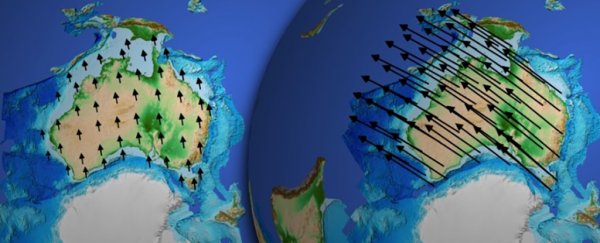Geophysicists have discovered something startling about tectonic plates: when under extreme stress, they hit the gas and can accelerate in speed by up to 20 times.
When they're about to split, the plates can move about as fast as the human fingernail grows, and that's very fast indeed as far as continental drift is concerned.
Scientists from the University of Sydney, Australia, and the University of Potsdam, Germany, used a combination of seismic data and computer modelling to map the varying speed of a plate breakups, and you can view the results online.
The University of Sydney's Dietmar Müller compared the process to pulling a piece of dough apart. "At first, separating it requires a lot of effort because the dough resists your pulling and stretches slowly between your hands," he said.
"If you're persistent, you'll eventually reach a point where the dough becomes thin enough to separate quite easily and quickly. The same principle applies to rifting continents once the connection between them has been thinned sufficiently."
Essentially there's a tipping point where the connection between two continents becomes too weak to resist the forces moving in the other direction, and that's where the action speeds up to fingernail-growing levels.
The research team looked at the ancient supercontinent of Pangaea, which now accounts for South America, Africa, Antarctica, India, and Australia. For 40 million years, the plates that made up Pangaea moved apart from each other at a rate of 1 millimetre a year.
Then a shift in gear happened, and for the next 10 million years the plates moved at 20 millimetres a year. According to the new model, the continents split completely some 173 million years ago.
The scientists say their findings help to explain plate motions that were previously baffling experts. In part that's due to new data becoming available in recent years that tells us more than ever before about these ancient rock movements.
The team pored over masses of this updated data, covering thousands of kilometres of land, to identify continental stretch points, before building a computer model to match.
And when a split happens, it's not pretty – rapid subsidence, high heat flow, and enhanced volcanic activity occur along the margins of the breakup, according to the scientists.
The researchers' findings, published in Nature, are part of a five-year project aiming to improve our understanding of how sedimentary basins and continental margins evolved, by using big data analysis (the advanced kind of number-crunching made possible by today's computing platforms).
The idea of a two-phase breakup now gives us a brand-new framework of how continental drift works.
"It's the equivalent of moving around as a pedestrian, to moving around in a very fast BMW," Müller told Nicholas St. Fleur at The New York Times.
